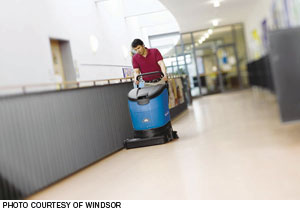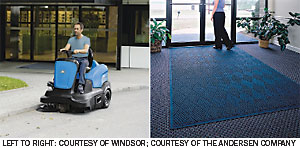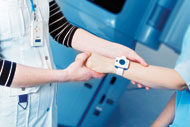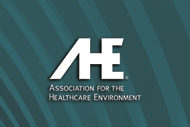The constant flow of people entering hospitals and other health care facilities can wreak havoc on hard floor surfaces.
 |
| Compact scrubbers are useful floor cleaning tools for small- to medium-sized jobs. |
Research shows that 1,000 people entering a hospital every day for a year will bring with them 288 pounds of soil. This includes dirt, clay, sand, leaves and grass clippings as well as more problematic substances such as oil and grease, mold spores and fungi.
These soils can damage hard floor surfaces in many ways as they are tracked through the hospital. To give just one example, the average grain of sand has 32 cutting edges, which abrade floors with the equivalency of 120-grit sandpaper.
This intrusion of soil into the health care environment is a thorny and costly problem that requires a well-conceived floor maintenance program to attack.
Preventive maintenance
Keeping soils from entering the facility is the most critical and overlooked component of floor maintenance. Highly efficient and effective floor care programs take an "outside-in" approach, beginning where the soils originate—exterior paved areas like parking garages, parking lots and walkways.
Regular sweeping is an important but often underappreciated part of a maintenance program for the exteriors of facilities. Sweeping walkways daily and parking areas up to 80 feet from entrances twice a week reduces the amount of soil entering the facility by 66 percent. Riding sweepers can help reduce labor when dealing with large outdoor areas, including parking facilities. Small powered or manual sweepers are effective with smaller areas, such as sidewalks and other walkways.
In addition to soil, garages and parking areas are the source of harmful oils that can be tracked into the facility. These oils tend to leave a yellowish brown traffic lane that requires constant maintenance on finished floors. Depending on traffic and soil load, garages and parking areas should be pressure washed once or twice a year to minimize the impact of these substances on flooring.
The final defensive barrier for keeping soils out of facilities is exterior matting. Exterior mats scrape large particulate soils from shoes and contain them so that they are not picked up by others and tracked into the facility.
The biggest mistake health facilities professionals make in this area is using carpet mats—which do not effectively contain soils—outside their facilities. Best results are obtained with ridged mats that have channels at least one-quarter inch deep. These mats capture soils by allowing them to fall into the channels and away from foot traffic.
Exterior mats should be vacuumed several times a week when they are dry and pressure washed as needed. Vacuuming the backs of ridged mats is the most effective way to clean them, given their unique construction. Most upright vacuums with properly adjusted beater bars or brush bars will beat the soil out of the overturned mats and the dirt can be easily swept away.
Managing the spread
Interior matting should complement exterior mats to most effectively control the spread of soil into facilities. The best of these indoor carpet mats are durable, with tightly configured fibers that hold dirt on the surface. This gives them a maintenance advantage over traditional tufted carpets, which trap dirt below the surface in pockets between the tufts. Carpet of this construction is also suitable for other areas of the hospital.
As the last line of defense against the intrusion of soils into health care facilities, daily maintenance of interior mats is critical. A commercial upright vacuum cleaner provides the necessary agitation to maximize dry soil removal. Monthly hot water extraction cleaning removes harmful oils and oily soils.
The amount of soil retention with these mats is directly proportional to their size. Industry studies have shown that the most effective systems have 18 linear feet of exterior matting in conjunction with 18 linear feet of interior matting. This enables the average adult entering a hospital to take six steps on both interior and exterior mats, which removes 99 percent of foot traffic soil.
An exterior-interior matting system is particularly important at emergency room entrances. In addition to heavy foot traffic, these entrances generally have significant rolling traffic from gurneys and wheelchairs. Rolling traffic inflicts a high toll on floors from dry soils that are embedded into the rubber wheels. The amount of weight put on these wheels is extraordinary and greatly exacerbates the effect of the soils on the floor.
Daily maintenance tips
Soils that settle on hard floors must be removed regularly to prevent damage from foot traffic. This is generally accomplished through dust-mopping or sweeping and then scrubbing the floors daily.
Environmental services personnel should not allow the soils to accumulate in front of the dust mop as it is being pushed down the floor. The natural air movement created by pushing the mop can catch the lighter, smaller soil particles and potentially put them back into the air where they can enter the lungs.
Power sweepers can more effectively remove the soils from the floor than manual dust mopping, even in the interior environment. These sweepers contain the soils so that they do not become breathable and some are equipped with vacuum filtration to contain small particulates.
Once the dry soils are removed, floors must be scrubbed to remove oily or sticky residue. This can be most effectively and efficiently accomplished with cylindrical scrubbers equipped with wet-sweep trays. These scrubbers have brushes that spin like rollers and pick up the soils from the floor and deposit them into a bin. This effectively eliminates the need for, and the labor cost associated with, dust-mopping or sweeping.
In the interim
Effective soil prevention and daily maintenance can significantly reduce the damage to floors from soil intrusion, but do not preclude the need for periodic interim maintenance. This is necessary because abrasive soils scratch and pit floors over time, eventually causing them to lose their gloss and mirrorlike appearance.
The simplest and least costly form of interim maintenance on finished floors is burnishing, which removes the peaks of the scratches in the finish and restores the gloss. The process essentially grinds the top layer of finish off the floor, so dust control is an important consideration in selecting a burnisher.
Burnishers feature either active or passive dust control mechanisms. Those that actively control dust have a vacuum motor that creates airflow that pulls the dust into a collection medium, such as a high-efficiency particulate air (HEPA) filter or bag. Burnishers that passively control dust do not have a vacuum. In that case, the airflow simply directs dust into a bag based on the shape of the cover over the burnishing pads. The best burnishing results are achieved, and time and labor costs are significantly reduced, when the pad is compatible with the finish. Suppliers of floor finishes can be a valuable source of information on matching the right pad with the finish. Applying a restorative chemical, which softens the existing finish, also can optimize the results of burnishing.
If burnishing does not produce the desired results, the next steps are top scrubbing and recoating. Floors are generally protected with between four and six coats of finish. Top scrubbing uses a more aggressive pad to remove the first one or two coats of this protective layer, which is where the damage is greatest. These coats are then replaced, which restores the gloss.
The restoration step
Restoring floors is by far the most costly step in a floor maintenance program. It first involves removing all of the finish from the floor—a time-, chemical- and resource-intensive process.
 |
| LEFT: Riding sweepers can help reduce labor when dealing with large outdoor areas such as parking lots and decks. RIGHT: The best indoor carpet mats are durable, with tightly configured fibers that hold dirt on the surface where it can be easily vacuumed. |
Floor finish removal requires application of a chemical stripper to break the bonds among the polymers in the floor finish. This is a 10-minute process and the stripper should not be allowed to dry during this period, even if it means applying water to it.
After 10 minutes, the floor can be scrubbed with a low-speed rotary machine or a cylindrical scrubber. Both are effective but cylindrical machines are more efficient because the spinning motion of their brushes creates a centrifugal force that keeps the finish off them. The pads of low-speed rotary machines must be changed every few minutes because the finish adheres to them.
Once the floor has been scrubbed, the finish is recovered with a wet-dry vacuum. For best results, all the finish must come off the floor. Particular attention should be paid to the edges and corners, which may need to be scrubbed by hand.
When the floor has been completely stripped and cleaned, it should be mopped with water or a mildly acidic neutralizing product to ensure that it has a neutral pH, which can be checked with a pH meter or pH paper. Once the floor has been neutralized, it is finally ready for the new finish.
Selecting the appropriate finish is critical. Soft finishes retain a high shine with daily burnishing, while harder finishes have a lower-gloss shine but do not require as much maintenance.
Another important consideration in selecting a finish is the amount of solids the finish contains. There is a direct correlation between the percentage of solids—the amount of finish left on the floor once the liquids have evaporated—and the number of coats that need to be applied. Experienced floor technicians apply the "rule of 100 percent" in determining the number of coats. For example, finishes with 20 percent solids require five coats of finish, while those with 25 percent solids require four coats.
Once the appropriate finish has been selected, the two most important factors in successively finishing a hard floor are maintaining control of the finish and evenly applying it, which leads to even drying.
Finish that is applied with a normal rayon mop is difficult to control and often ends up on baseboards, doors, carpet and other areas where it is not intended. This results in unnecessary work and higher costs to recover the renegade finish. Cleaning finish from hard surfaces requires application of a spray-on stripper, followed by wiping the surface clean. Finish can be removed from carpeted areas by applying an alkaline spray, agitation with a rotary brush or cylindrical interim carpet cleaning machine, followed by extraction. Floor stripper should never be used to clean finish from carpet.
A cardinal rule in efficiently and effectively laying finish on hard floors is to ensure that each layer is completely dry before the next coat is applied. Failure to do this will cause pockets of gas to be trapped between two layers of finish, resulting in bubbles. If this occurs, the floors must be rescrubbed to remove the bubbles and the finish reapplied.
Applying finish with a flat microfiber mop using a figure-eight pattern is the best way to avoid these pitfalls. These mops distribute the finish smoothly and evenly and pick up excess finish every time they hit the bead of finish. This allows for even application and fast drying. Additionally, the flat mop virtually eliminates the possibility the finish will end up in places where it is not intended.
Applying every layer of finish wall-to-wall is not necessary because foot traffic is not common along the edges. The first coat of finish should be approximately two inches from the walls, the second coat four inches away from them and so on. Only the last coat should be wall-to-wall.
A high return
The cost of removing a single pound of soil from an indoor environment is $700, according to industry research. The high number of patients, visitors and staff entering health care facilities makes it easy to understand how floor maintenance costs can unnecessarily escalate to millions of dollars annually.
The most efficient and effective floor maintenance approach is to concentrate on preventing soil from entering a facility and removing lesser amounts of soils that find their way inside quickly and effectively. The result will be significantly reduced labor and chemical costs.
Most importantly, an outside-in approach to hospital hard floor maintenance will result in consistently clean floors that have a much better overall appearance and provide a much more pleasant experience for patients, staff and visitors.
Richard Bodo is director of training for Windsor, Englewood, Colo., and is certified as a Master Textile Cleaner by the Institute of Inspection, Cleaning, and Restoration Certification (IICRC). He can be contacted via e-mail at richard.bodo@windsorind.com.
| Sidebar - Equipment maintenance is key |
| Proper health care floor maintenance is directly related to proper maintenance of cleaning equipment. Thus, dust mops should be laundered monthly, followed by the application of commercial chemicals that maximize the amount of dust and other particles they can capture. For best results, the chemical should be poured evenly through the backing of the mop. The mop should then be placed in a plastic bag for 24 to 48 hours, allowing the chemical to wick and work its way through the cotton fibers. Another option is the use of microfiber dust mops, which do not require any treatment to maximize their cleaning performance. Scrubbers should also be well-maintained, especially brushes, pads and squeegees that come in contact with the floor. They should be clean and free of debris, so that they do not contribute to the dulling and abrasion of floors. Clean squeegees can effectively recover the soil and solution from the floor and eliminate unsightly streaks. |





